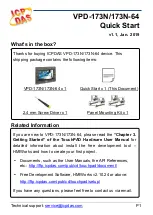
19
©2018 Hubbell Incorporated | Chance
®
Capstan Hoist Operating Instructions
Maintenance
When properly cared for, the Capstan Hoist should provide years of trouble-free service. Abuse,
misuse, overloading and/or shock loading will damage the unit rendering it unsafe for operation.
If any
component of the capstan hoist system is damaged or does not function properly then remove the
hoist from service. Properly tag and return it to the manufacturer for repairs.
A brief inspection of
the Capstan Hoist before each use is essential for safe, economical and trouble-free operation.
Rotating Drum
• Inspect the drum to ensure it is bolted securely into place.
• Inspect the drum plating and surface condition for damage. The drum surface should be
completely smooth, exhibit no grooving, free of dents and raised imperfections that would cause
abrasive damage to the rope. The drum plating should be fully intact and free of rust.
• Inspect the drum edges for dents, which may suggest that the hoist has been dropped or
abruptly impacted. Such wear can lead to the damage of other hoist components.
• Ensure the drum is secure to the motor, rotates in only one direction and does not have backlash.
Rope Hook
• Inspect the rope hook to ensure it is present and bolted securely in place over the top of the
drum and loops into the end of the drum.
Foot Control
• Inspect the foot control to ensure it is free of nicks, kinks and bends.
• Inspect the foot control end fittings and connections to ensure they are securely tightened into
position.
• Test the foot control switch under a no-load condition to ensure smooth and proper on/off
operation.
Electric Motor
• Inspect the power cord and plug for cuts or fraying.
• Confirm the power cord is securely mounted to the motor and not pulled loose.
The cord is not
a handle for carrying the hoist.
• Confirm the ground prongs on the power cord are in place and not damaged.
• Do not cut or remove the power cord grounding prong. Use only 3-wire power cords with the
grounding prong and socket intact.
• Inspect all cords, plugs, etc. for proper size. Undersized cords increases current draw and will
damage the electric motor.
• Inspect the electric motor for any external damage. Dents to the electric motor may suggest that
the hoist has been dropped or abruptly impacted. Such wear can lead to the damage of other
internal hoist components, especially the brushes, magnets and the rotor.
• Test the electric motor under a no-load condition to observe for excessive sparking, arcing,
grinding, crackling, hitting or stalling. The hoist should run smoothly.
















































